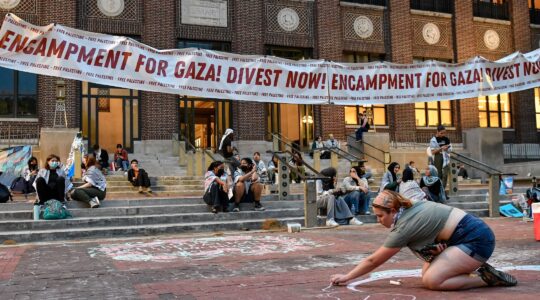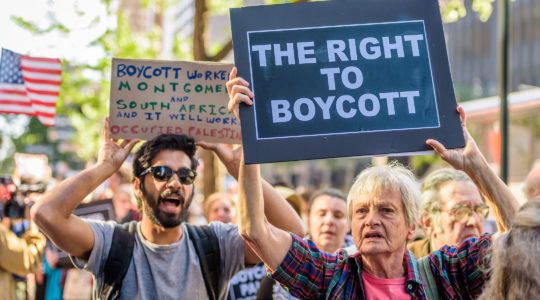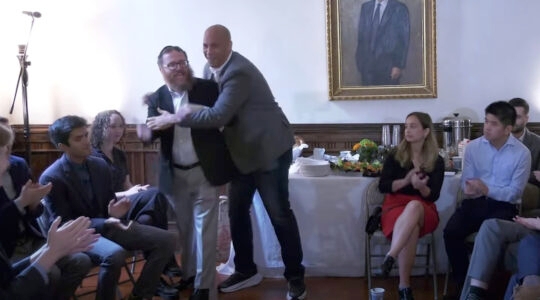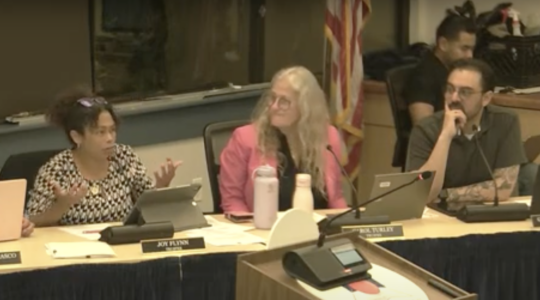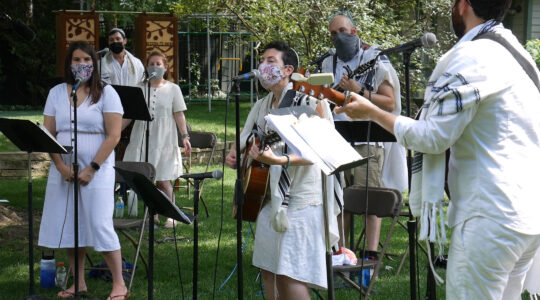
Nobel laureate Elie Wiesel, left, and Jewish Agency for Israel Chairman Natan Sharansky at the General Assembly of the Jewish Federations in North America in Baltimore discussing the Soviet Jewry movement and marking the 25th anniversary of its pinnacle event, The March on Washington, Nov. 12, 2012.
(David Karp)
BALTIMORE (JTA) — A year since its creation, the grandly named Global Planning Table remains the great white hope of the Jewish Federations of North America, which held its annual General Assembly here this week.
Introduced a year ago, the GPT aims to reshape the way federations spend money outside their local communities by making decisions on collective spending more transparent and communal. Federation officials hope this will stem the decline in overseas spending and bring more clout — and money — to federations’ collective action.
“Some say the federation system is an old model that won’t survive” because donors are more independent, Kathy Manning, the outgoing JFNA board chair, said at the GA’s opening plenary on Sunday. “I believe the secret of the Jewish community’s success is our ability to act together.”
A year on, the GPT is still in its embryonic stages. No money has been doled out under GPT guidelines, and over the summer the professional director of the project resigned. The Jewish Federations subsequently announced that implementation of the GPT, which will end the traditional arrangement by which federation overseas dollars automatically went to the Jewish Agency for Israel and the American Jewish Joint Distribution Committee along a 75/25 percent split, will be delayed by a year.
“This is slower than I would like it to be, but I understand we have to get a lot of buy-in,” Jay Sanderson, president of the Jewish Federation of Greater Los Angeles, told JTA. “I’m still optimistic we can get the right thing done, but something has to happen in 2013. There needs to be some tachles,” he said, using the Yiddish term for substance.
The central challenge of the Jewish federations, which together raise nearly $3 billion per year, has not changed in recent years. These clearinghouses of Jewish charity must figure out how to keep the community committed to a system of collective action in an era when American Jewry is increasingly fragmented, less institutionally affiliated and more restrictive than ever when it comes to philanthropic spending.
Most of the time, that’s a tough sell.
But then a crisis like Hurricane Sandy comes along, and the need for a system that can harness the collective power of the community suddenly becomes readily apparent. In the space of just a few hours on the Sunday after the storm hit, the executive board of the UJA-Federation of New York made $10 million immediately available to Jewish institutions and people struck by the largest storm in memory to strike the northeastern United States.
“Responding to people in suffering is what we do,” Jerry Levin, president of the UJA-Federation of New York, said at the GA. “This is the federation system.”
Absent a crisis, however, mustering collective action faces two major obstacles: decision-making and motivation. How can 156 federations, each with its own agenda and priorities, come to agreement on spending decisions? And how can they motivate donors to give in support of those decisions?
Federations hope the GPT is the answer.
“The Global Planning Table could be terrific if they decided what the things are that we can do to bend the future,” Barry Shrage, president of the Boston federation, Combined Jewish Philanthropies, told JTA. “The federations are still the richest, most powerful force in American Jewish life. We can change the world if we know what we want to do.”
So far, the discussion, research, consultation and committees connected to the GPT have resulted in the identification of four spending priorities: strengthening Israel; developing leadership and community; caring for vulnerable populations; and building Jewish identity and connections. The federations hope they’ll be able to launch one to two new initiatives next year that support those priorities.
“The potential still remains that the GPT will be able to gather enough momentum,” said Alan Hoffman, director-general of the Jewish Agency. “It’s all about the power of ideas to engage the hearts and minds of donors. This is about the future of the federation movement.”
While the GPT dominated insider buzz at last year’s GA held in Denver, this year’s assembly seemed to lack a comparable big issue.
“I feel like it’s smaller, though that may be the venue,” said Susan Holzman Wachsstock, executive director of a group called Jewish Student Connection that seeks to enrich Jewish experiences for Jewish public school students. “I also think the content is much leaner than in previous years. The plenaries, however, were the best I’ve seen in years.”
The conference site, the sprawling Baltimore Convention Center, dwarfed the 3,000 attendees, often making it difficult to find a crowd. There were no real star headliners — unless you count Nobel laureate Elie Wiesel or Edon, the kipah-wearing singing sensation from “America’s Got Talent” — and no one from either the Obama administration or the Israeli Knesset showed up.
While attendance at other major Jewish gatherings has continued to climb year after year — AIPAC’s annual conference now draws a crowd of more than 10,000, and 6,000 showed up to last year’s Reform biennial, which also featured President Obama — the GA seems stuck at about 3,000. It wasn’t even the largest Jewish gathering of the week in America. That distinction went to the International Conference of Chabad-Lubavitch Emissaries, which drew more than 4,000 supporters and Chabad outreach emissaries to New York.
“There needs to be more of a reason to get people here,” said L.A.’s Sanderson. “It’s not just about who speaks. Everything here is frontal, but the Jewish world is not frontal anymore. This is not an engaging setup. Maybe it doesn’t have to be every year. Maybe it should be every other year.”
For many, the confab is not so much a pep rally as an opportunity for networking. Representatives of American Jewish and Israeli organizations hoping for federation support come to pitch their programs and meet federation leaders. Federation executives come to meet with their colleagues. More than 300 college students and 100 high schoolers were brought to this year’s conference.
Stephen Hoffman, a former president of the federation umbrella organization and now president of the Cleveland Jewish federation, said the GA is “not a place to convert the unwashed — people who aren’t involved in federation.” Rather, he said, “It’s a place to reinforce the values and motivation of people who are engaged in the leadership ranks.”
But Sanderson says GAs need to be attractive to more than just core professionals and lay leaders.
“We need a lot more home runs,” he said. “This is a walk at best.”
One moment of excitement that belied that analysis, many participants said, came in the closing assembly, when Rabbi Rick Jacobs, president of the Union for Reform Judaism and the GA’s official scholar in residence, delivered a call to stand up for religious pluralism in Israel.
“So long as Israel remains the only democracy that legally discriminates against the majority of Jews who are in the non-Orthodox streams, the Zionist dream of the ingathering of the exiles in a Jewish state for all Jews cannot be fully realized,” Jacobs said in a speech punctuated by rousing applause. “It is time to end this discrimination once and for all.”
JTA has documented Jewish history in real-time for over a century. Keep our journalism strong by joining us in supporting independent, award-winning reporting.
